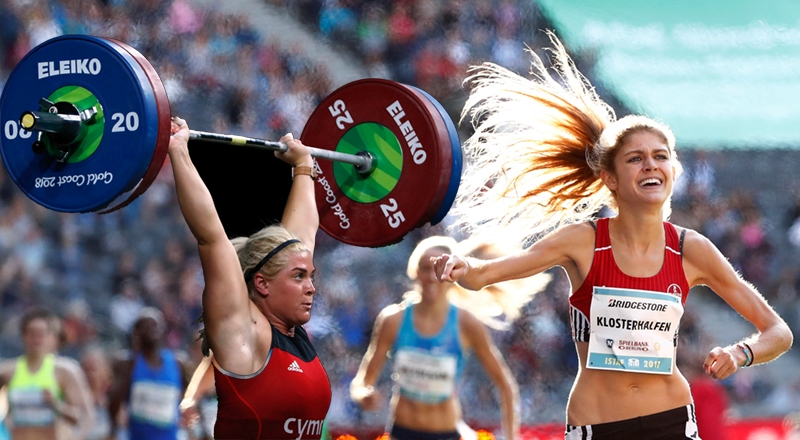You are viewing 1 of your 1 free articles. For unlimited access take a risk-free trial
Aerobic training vs. strength training: do they cancel each other out?

Many sports are characterised by the need to blend multiple fitness components in order to achieve optimum performance. These include football, hockey, netball, basketball and many others. As an athlete involved in such a sport, you are unlikely to have the luxury of training any one of these components in isolation over a period of time, and your conditioning programmes probably involve the concurrent training of several fitness components across a number of microcycles.
But is there a risk that by engaging in two or more different types of conditioning at once, the differing stimuli will interfere with each other – even, in effect, cancel each other out?
Recent research on the effects of concurrent strength and aerobic training appears contradictory, with some authors suggesting that gains, particularly in strength, may be compromised and others detecting no such ‘interference’. In order to maximise your training investment, you need to be aware of whether this interference effect really does exist, when and why it occurs, what harm it does and what strategies can be employed to minimise its effects.
An interference effect is said to have occurred when targeting two or more conditioning components in the same microcycle of a phase leads to a lower gain in any one component than would have been expected if it had been trained separately. In recent years, researchers have investigated several possible negative effects of concurrent conditioning on training adaptation.
As far as aerobic adaptation is concerned, most studies have suggested that concurrent strength and endurance training do not interfere with the development or maintenance of this aspect of fitness, although its development may be less pronounced than through aerobic training alone. It must also be said that no study has reported deterioration in either strength or endurance as a result of concurrent training, and most have reported significant gains.
But as far as strength adaptation is concerned, the evidence is less clear. Only one of the studies reviewed reported no significant strength gain following a concurrent programme. However, most of the studies comparing the effects of concurrent training with strength training alone reveal compromised strength gains, with investigators reporting either lower-than-expected gains, a levelling off of gains after a few weeks, or a levelling off followed by a decrease after several weeks.
It should be noted that some studies report strength gains after concurrent training similar to those achieved after strength-training alone. These studies tended to have one or more of the following characteristics:
- a low total training volume or strength training volume;
- a moderate total volume consisting of three or four sessions per week;
- a rest day between training sessions (strength and aerobic training sessions held the same day);
- aerobic efforts of moderate intensity (ie 30-60 minutes at approximately 70% of VO2max);
- interval training at high intensity (ie 90-100% of VO2max) but low volume, and/or progressive overloading.
1. Muscle response
In order to repair damage resulting from conditioning sessions, and thus build a training effect, muscle cells must draw on their energy and nutrient pool. Too many demands on this pool, however, will reduce the ability of the cell to respond. Building training effects in more than one fitness component at the same time (ie concurrent conditioning) could therefore reduce the ability of the cells to respond optimally. The reason why this appears to interfere most with strength conditioning is to do with the different types of muscle fibres used and the time it takes to build the training effect.
Response to the training stimulus differs greatly between the two modes of conditioning. Aerobic training effects are built 12-24 hours afterwards, while it takes 24-72 hours to build strength adaptations, with the highest rate of building taking place in the first half of this period, then tapering off. Therefore, strength adaptations can be affected over a much longer period of time than aerobic adaptations. In practical terms, this means that athletes engaged in both strength and aerobic training on the same day should:
- leave as long a gap as possible between the two types of training;
- make sure the aerobic conditioning component is of low intensity and moderate duration in order to recruit primarily slow-twitch fibres, and/or
- make sure the aerobic conditioning involves different muscle groups from those targeted during strength-training.
Research has suggested that aerobically-induced muscle fatigue decreases the quality and quantity of subsequent strength conditioning, displayed as a reduction in the number of reps and/or sets completed. Over a training phase this will have the effect of reducing training load progression and, in consequence, total strength gain during the phase.
Both sequencing of conditioning and length of recovery period between sessions are key factors in the extent of fatigue experienced. Since strength training appears to be more susceptible to interference than aerobic training, recovery before strength conditioning is crucial to maximising its benefits. The potential quantity of strength conditioning that can be performed is reduced for up to eight hours following an aerobic-training session, but only in the specific muscle groups targeted by that training.
(Although anaerobic conditioning – speed, speed endurance and explosive power – is not covered by the studies mentioned in this article, it is likely that this type of training would also interfere with strength training effects, and vice versa. Again, this is most likely in the muscle groups common to both modes of conditioning.)
In practical terms, the evidence on fatigue suggests that when programming strength and aerobic power/capacity conditioning on the same day, strength should be targeted in the morning and aerobic fitness in the late afternoon. Alternatively, different muscle groups should be targeted in the two sessions. The relevance of fatigue to any possible interference effect emphasises the need to replace glycogen stores and rehydrate after every training session. In addition, it demonstrates the importance of including one or more rest days within each microcycle to help maximise the training benefits.
In conclusion, despite the limitations of the studies mentioned in this article – the use of sedentary or minimally-trained subjects, using relatively low training volumes – a few key trends can be discerned.
Concurrent strength and aerobic conditioning can result in significant improvement of each quality over a period of a few weeks, and it is associated with a relatively ‘normal’ development of aerobic qualities. In fact, an increase in strength can translate into a significant improvement in aerobic performance, even though VO2max may remain unchanged. However, there is some evidence to suggest that strength gains, particularly at high contraction speeds, can be undermined by a few weeks of concurrent conditioning. This is particularly likely to be the case when the total training volume is high given the level of the subjects involved, the volume of aerobic conditioning is substantial (more than three sessions per week) and/or overloading is not gradual.
The potential for ‘interference’ to dilute gains emphasises the need for a thoughtful approach to developing a conditioning programme, particularly when a building block approach is used to determine the sequence of conditioning sessions over time.
Whether the interference effect results from strain on the adaptive processes or fatigue, the solution is to perform the high-intensity work in as rested a state as possible. Training should be scheduled so that high-intensity work in similar muscle groups is spaced 24-48 hours apart, with intervening conditioning sessions being low in volume or targeted at different muscle groups. If aerobic conditioning is scheduled before strength training, there should, ideally, be a gap of at least eight hours between the two sessions or use of completely different muscle groups. If aerobic conditioning follows strength work, then it should involve different muscle groups and low work volume (<45 min) and intensity (<70% VO2max).
Andrew Harrison
Newsletter Sign Up
Testimonials
Dr. Alexandra Fandetti-Robin, Back & Body Chiropractic
Elspeth Cowell MSCh DpodM SRCh HCPC reg
William Hunter, Nuffield Health
Newsletter Sign Up
Coaches Testimonials
Dr. Alexandra Fandetti-Robin, Back & Body Chiropractic
Elspeth Cowell MSCh DpodM SRCh HCPC reg
William Hunter, Nuffield Health
Keep up with latest sports science research and apply it to maximize performance
Today you have the chance to join a group of athletes, and sports coaches/trainers who all have something special in common...
They use the latest research to improve performance for themselves and their clients - both athletes and sports teams - with help from global specialists in the fields of sports science, sports medicine and sports psychology.
They do this by reading Sports Performance Bulletin, an easy-to-digest but serious-minded journal dedicated to high performance sports. SPB offers a wealth of information and insight into the latest research, in an easily-accessible and understood format, along with a wealth of practical recommendations.
*includes 3 coaching manuals
Get Inspired
All the latest techniques and approaches
Sports Performance Bulletin helps dedicated endurance athletes improve their performance. Sense-checking the latest sports science research, and sourcing evidence and case studies to support findings, Sports Performance Bulletin turns proven insights into easily digestible practical advice. Supporting athletes, coaches and professionals who wish to ensure their guidance and programmes are kept right up to date and based on credible science.









